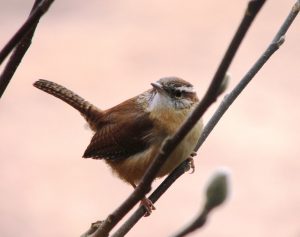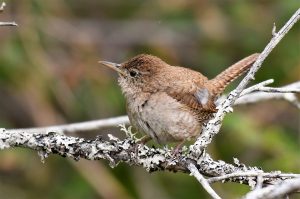If you have never seen wrens in your garden you will have probably heard them. They are one of the most common songbirds in the UK and spend their time in gardens and woodland the whole year-round.
They are particularly shy birds yet enjoy singing at the top of their lungs from branches low amongst the trees.
If you’ve ever wondered “what do wrens eat” and how you can encourage them out of their hiding places to dine in your garden, keep reading?

Wrens are insectivorous which means they primarily eat insects, spiders, and other small invertebrates. That isn’t to say some offerings from our kitchens won’t tempt them to make an appearance. Peanuts and suet just might pique their interest.
Wrens are predominantly ground feeders and prefer to forage through the grass and leaves to find their next meal. They frenetically hop and dash around the ground looking for beetles, spiders, and caterpillars.
Their natural habitat is quite unstructured, perhaps a little messy. If you don’t over-prune berry bushes, insects will make a beeline for them. Wherever there are copious amounts of insects, you can bet the wrens won’t be far behind.
Attracting wrens to feed in your garden is easier if there are no predators around. Cat-free gardens are much more appealing to the wren, particular as they’re safer areas to lay food directly on the ground or in ground-feeding trays.
Mealworms scattered around are very inviting, however, the wrens need to be up before the sparrows to get a look in. I soak my dried mealworms to re-hydrate them and fatten them up a little; they just look more appetising
Leaf piles attract hungry wrens, they know that beneath the layers will be teeming with invertebrates.
Table of Contents
What do wrens eat from the bird table?
It would be very unusual to see a wren at height eating from a hanging feeder. If they were enticed it would probably be by suet or peanuts.
I find the best way to encourage them to eat my offerings is with my home-made peanut butter. I use the blender and blitz down peanuts until they have a butter-like consistency. If I’m making it to put on toast I’d add a spoonful of honey, I’ve found the birds have developed a taste for that too. It’s much better than the stuff you buy in jars from the shops and much healthier and more nutritious for our feathered friends.
Spread it into an old jar lid, or better still around the base of a tree trunk, and watch the wrens appear.
Quiet Please
Any food you leave out for the wrens should be in quiet corners of the garden, preferably where there is some dense foliage. They move frenetically around the garden, fast on their feet to hide from danger quickly. Bushes provide the perfect hiding place for the timid little fellows.
Food and drink for wrens
When putting food out for wrens, be mindful that they need plenty of fresh water. Just as they like a choice of nesting places, the wren likes a selection of watering holes. Moving water is known to attract them so water fountains and features are ideal if you’re not fortunate enough to have a babbling brook running through your garden.

Final thoughts…
The wren is one of my favourite garden birds, probably due to his dumpy little body that maniacally hops and dashes everywhere at speed.
Knowing what wrens eat is the best way to encourage them to my garden and to try to prevent them from coming to harm during the cold winter months.

I live in south Louisiana Andy we are experiencing extremely freezing weather and I want to feed the small birds- wrens and sparrows. What would that be ?
This article details the food that Wrens like, we have another article about sparrows which details what they can be fed here.